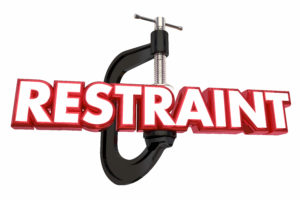Last week, I did a post on the use of restraints. For those who don’t know, I wanted to shed a little light into and hopefully provide a greater understanding of what restraints are in the educational setting.
As I stated in my blog post, To Restrain or Not to Restrain, the proper use of restraints is not a form of punishment, it is a measure for safety. Restraints are used for students who have demonstrated a propensity for harming oneself, others, or property. I am not referring to actions that include limited physical contact with a student to promote safety (holding a student’s hand), or to prevent a potentially harmful action (running into the street). What I am referring to are actions that uses physical force (physically taking a student to the ground) or a mechanical device (chair with seatbelt) that would significantly restrict the free movement of all or a portion of the student’s body.
The use of restraints is nothing new, having originated in the psychiatric hospitals of France during the 18th century and adopted by the United States as an acceptable practice for dealing with violent patients. At that time, the use of restraints was developed as a means of preventing patients from injuring themselves or others. Now, the intent is the same. The use of physical restraints was applied to children with emotional disturbances in the 1950’s, and has, over time, found its way into public education. This is, in part, due to the Individuals with Disabilities Education Act (IDEA), which establishes the principle of serving children with special needs in the least restrictive environment. Because of that, schools are now challenged to demonstrate practices that prevent or contain challenging and sometimes violent behaviors.
From their initial use, restraints have been controversial. After all, who wants to hear about, or see an adult/child physically taken down to the ground and held in a restrained position for any length of time! When used incorrectly and irresponsibly, restraint does lead to injuries and death. We have seen it in the news too many times. But, in all that has been said and done when it comes to the use of restraints, one thing has remained constant; that restraints, in some form or fashion, is still permitted and still needed! So, what are restraints?
Generally speaking, there are three forms of restraint.
Chemical Restraint. This type of restraint uses medication to control behavior or restrict a student’s freedom of movement. This type of restraint is very unlikely in most school settings other than those schools found within institutions or hospitals.
Mechanical Restraint. Entails the use of a device or object to limit an individual’s body movement to prevent or manage out-of-control behavior. In the educational setting, mechanical restraints can include weighted blankets, weights, and seat belts to name a few.
Physical Restraint. The most common, physical restraint is defined as any method of one or more persons restricting another person’s freedom of movement, physical activity, or normal access to his/her body. There are strict guidelines to follow when using restraints (such as the use of reasonable force) and things that should never be done (such as face down instead of to the side).
My first training on the use of restraints was at Napa State Hospital. My training was very extensive, and I had to pass certification before I was allowed to practice the use of restraints. Training included, but was not limited to, how to physically take down a patient, de-escalation techniques, alternatives to the use of restraints (restraints was always the last resort), and behavioral interventions. There were strict guidelines that governed the use of restraints as well. Such as restraints are not punishment, never restrain in anger, remain calm, last resort, etc. In all of the years that we used restraints in the hospital setting, we had zero incidence of death and very few injuries. There was a reason for that; our extensive training, our respect for the patients, and what we had to do.
I believe that is why there is an issue with restraints in the educational setting. The same guidelines and standards that govern training in the use of restraints in the medical, psychiatric, and law enforcements settings, are not the same in the educational setting. One article I read labeled training in the educational setting as “generic” and results in school staff with limited or no training. And, when it comes to restraints, it must be understood that restraints are only as effective as there are specialized supports and behavioral interventions that are in place. Restraints alone does not solve the problems of behaviors.
As I stated in my blog post, To Restrain or Not to Restrain, I still believe in the use of restraints. But I also believe that everybody who is not properly trained to restrain should never restrain. The use of restraints requires a certain mindset, a certain attitude, a certain level of respect. That was why certain ones who trained in the use of restraints did not pass the training when I worked at Napa State Hospital. One should never restrain out of or in anger. One should never restrain because one does not like a particular student. One should never restrain because one does not like what a student did or did not do. One should always be mindful of his/her own strength and size. Restraints should always be considered the measure of last resort… but it should be considered when the welfare of the student, the other students in the classroom, the teachers and para-educators, and property are in danger of being hurt or destroyed.
Do you have a restraint story you would like to share?



